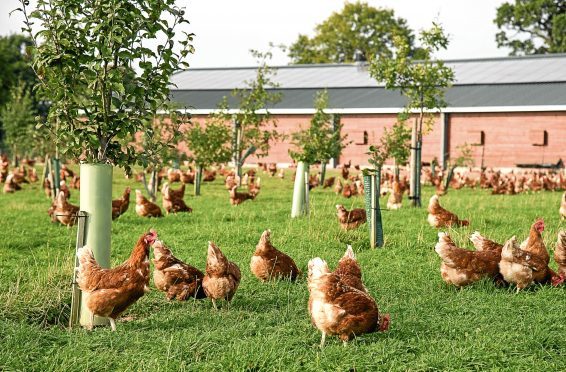A project aiming to improve understanding of how trees can impact on chickens has helped Scotland’s biggest egg producer increase bird welfare and drive egg production.
Glenrath Farms has seen egg numbers rise thanks to a scheme which saw them plant trees around housing they built for 64,000 hens on Kirklawhill Farm in Biggar, Peebleshire.
Working with the Woodland Trust, the Campbell family planted species including oak, alder, birch, willow and Scots pine to find out how bird behaviour could be impacted by trees.
The project has been so successful that the family say more of Scotland’s free-range poultry farmers should consider planting trees on their farms.
“We planted the trees in 2014 after buying the farm because we wanted to do something that would benefit the wider community as well as our hens,” says Karen Campbell, the farm’s operations director.
“We weren’t 100% sure what format we wanted to plant them, so we got advice from the Woodland Trust and decided to plant in two different systems, in rows and in sheltered clumps, to see which would suit our birds the best.”
Under the project the trees are managed by the Woodland Trust, with Glenrath Farms managing the fencing to ensure the trees are protected from other livestock.
Two batches of hens have been through the farm since the trees were planted, and Karen says the results have been hugely encouraging.
“The birds are enjoying having the trees there, they really like the trees which are planted in clumps near to the hen house,” she says.
“On both systems though we have seen extremely good figures: the plumage is very good and we have achieved the magic figure of at least 300 eggs in a cycle – one was 320 and the other was 315.
“That’s the difference between profit and loss for a poultry farm, so it means we are sustainable.”
Karen says she is confident the trees have contributed to the improvements, as the birds are more relaxed because they are able to shelter from extremes in weather.
“It’s quite an exposed site and hens don’t like the wind, so the birds enjoy the shelter. They also feel more secure from predators and planes flying overhead, so their fear and stress levels are much lower.
“The birds haven’t really had any medication at all, which is a good indication, especially when birds that go outdoors can pick up diseases more easily than housed birds.”
Karen says working with the Woodland Trust’s Perth office has been a valuable experience, enabling them to get advice on everything from the types of trees which fit in with the landscape, to understanding which species would establish well on their land.
“As farmers we’re not experts in trees, but this has been really positive and the Woodland Trust has been very easy to work with,” she says. “If your not sure about the types of trees that will suit your land then its definitely worth getting in touch with them.”
In future she says the family plans to continue planting more trees across their farms, while they are also experimenting further on how birds adapt to trees in their environment.
“We planted 10,000 trees in the last year, as it’s a cycle as we are always harvesting and planting,” she says. “We have also planted an orchard to see whether the birds like eating apples.
“We’re having visitors from across the UK and even the US who are interested in what we’re doing, so hopefully we can help more farmers understand how trees could help their systems.”
